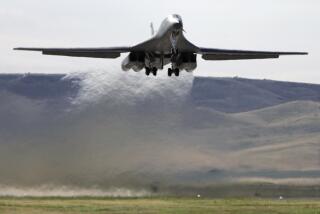B-2 Bomber Fails Tests in Evading Radar
Air Force Secretary Donald Rice disclosed late Wednesday that the Northrop B-2 Stealth bomber failed recent tests of its ability to operate undetected by enemy radar--a potential political bombshell for the controversial $64.8-billion program.
Rice said that in a recent flight test, measurements of the B-2’s Stealth capability “did not meet the desired levels of performance.” According to congressional sources, the failure stems from a potentially serious technical problem that is likely to be seized upon by B-2 opponents.
Without a clear stealth capability, the entire justification for the B-2 program would be thrown open to doubt, congressional sources said. A major weakness in the detectability of the B-2, which is produced in Palmdale and Pico Rivera, would “go to the guts of the program,” a House staffer said.
But Rice’s statement asserted that even with the recent test failure, the B-2 remains “the most survivable aircraft in the world and will provide unmatched power projection and deterrence.” He added that the “fundamental soundness” of the B-2’s Stealth design has been confirmed by the tests.
Rice is scheduled to meet today with Rep. Les Aspin (D-Wis.), chairman of the House Armed Services Committee, to brief him on the test results. Aspin is a leading opponent of the B-2 and led the fight in the House of Representatives to stop the B-2 program.
Rice met Tuesday with Sen. Sam Nunn (D-Ga.), chairman of the Senate Armed Services Committee.
The disclosure of the problems comes at an inopportune political juncture for B-2 supporters. A House-Senate conference committee is starting to resolve differences in the chambers’ B-2 budget authorizations for the 1992 fiscal year. The Senate authorized the Air Force to buy four more B-2s, but the House authorized no new aircraft beyond the 15 on order. The Air Force eventually wants 75 of the aircraft at an average cost of $864 million each.
The House staffer said Wednesday that the timing of the disclosure was designed to avoid any suggestion that the Air Force sought to withhold damaging information until after the conference panel had committed money to the B-2. In addition, Pentagon officials are legally bound to disclose such problems on major procurement programs, he said.
“This would be another A-12 scandal if they allowed the conferees go ahead on the B-2 authorization and came in afterward with the bad news,” the source said, referring to the troubled Navy attack jet program canceled early this year.
“That would have left the secretary (Rice) holding the bag,” the staffer said. “If it wasn’t extraordinarily serious, they wouldn’t be rushing in like this.”
Rice’s statement put a different light on the disclosure. The purpose of the testing, Rice said, is to measure the performance of the aircraft and to “make adjustments where required.” He also said that the failed measurements were “among many observations of interest” and that “a number of such measures have been improved during the test program to date.”
In addition, Rice said the Defense Science Board “has reviewed all the test data, including the recent flight test, and finds no justification for any change to the program schedule.”
The batlike B-2 is called a flying wing because it lacks a conventional fuselage and tail. The shape, and its plastic skin and other features, are intended to prevent enemy radar from locating and tracking the aircraft.
A key aerospace industry source said the recent tests at Edwards Air Force Base that the B-2 failed involved certain types of potential enemy radar threats. He declined to specify what types of radar threats, but acknowledged that a great deal of concern has focused on the ability of very low frequency radar to detect the B-2.
The source insisted that the problem could be resolved by switching to an alternative technology--but at an undetermined higher cost. He suggested that the cost would be “a few hundred million dollars.”
The fix would not affect the aircraft’s exterior shape or aerodynamic performance, he said. Instead, either a coating on the aircraft or an electronic system would be altered or added, he acknowledged.
The problem with the failed radar test is not the first one to surface with the bomber. The Air Force has disclosed that the rear deck of the plane is subject to cracking. A plan to repair the decks of early B-2s and redesign the decks of later bombers will cost about $200 million.
An Air Force spokesman said he could not go beyond the statement issued by Rice. But the spokesman did indicate that Defense Secretary Dick Cheney did not direct Rice to make the statement to Congress and that Rice was making it at his own discretion.
Northrop officials referred all questions to the Air Force.
More to Read
Sign up for Essential California
The most important California stories and recommendations in your inbox every morning.
You may occasionally receive promotional content from the Los Angeles Times.










